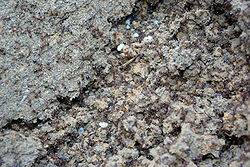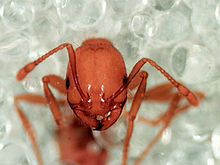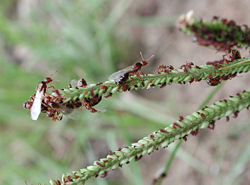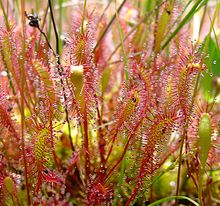Fire ant
| Fire ant Temporal range:
| |
|---|---|

| |
| Scientific classification | |
| Domain: | Eukaryota |
| Kingdom: | Animalia |
| Phylum: | Arthropoda |
| Class: | Insecta |
| Order: | Hymenoptera |
| Family: | Formicidae |
| Subfamily: | Myrmicinae |
| Tribe: | Solenopsidini |
| Genus: | Solenopsis Westwood , 1840
|
| Type species | |
| Solenopsis geminata Fabricius, 1804
| |
| Diversity[1] | |
| 201 species | |
Fire ants are several species of
None of these names apply to all species of Solenopsis nor only to Solenopsis species; for example the colloquial names for several species of
Appearance


The bodies of mature fire ants, like the bodies of all typical mature insects, are divided into three sections: the head, the thorax, and the abdomen, with three pairs of legs and a pair of antennae. Fire ants of those species invasive in the United States can be distinguished from other ants locally present by their copper brown head and thorax with a darker abdomen. The worker ants are blackish to reddish and their size varies from 2 to 6 mm (0.079 to 0.236 in). In an established nest these different sizes of ants are all present at the same time.[4]
Solenopsis spp. ants can be identified by three body features—a
Behavior

A typical fire
These ants are renowned for their ability to survive extreme conditions. They do not hibernate, but can survive cold conditions, although this is costly to fire ant populations as observed during several winters in Tennessee, where 80 to 90% of colonies died due to several consecutive days of extremely low temperatures.[9]
Fire ants have been known to form mutualistic relationships with several species of Lycaenidae and Riodinidae butterflies.[10][11] In Lycaena rubidus, the larvae secrete a fluid that is high in sugar content. Fire ants bring the larvae back to the nest, and protect them through the pupal stage in exchange for feeding on the fluid.[11] In Eurybia elvina, fire ants were observed to frequently construct soil shelters over later instars of larvae on inflorescences on which the larvae are found.[10]
Fire ants nest in the
Fire ants are resilient and can survive floods. During Hurricane Harvey in Texas in 2017, clumps of fire ants, known as rafts, were seen clumped together on the surface of the water. Each clump had as many as 100,000 individual ants, which formed a temporary structure until finding a new permanent home.[14] Ants clumped in this way will recognize different fluid flow conditions and adapt their behavior accordingly to preserve the raft's stability.[15]
Fire ants dig tunnels efficiently using about 30% of the population of the colony, thereby avoiding congestion in tunnels.[16]
Queens, males and workers

Queen
Fire ant queens, the reproductive females in their colony, also are generally the largest. Their primary function is reproduction. Typically, a fire ant queen will seek to establish a new colony following a nuptial flight, wherein it will use its special venom to paralyze offending competitors,[17] in the absence of workers for defense. Fire ant queens may live up to seven years and can produce up to 1,600 eggs per day, and colonies will have as many as 250,000 workers.[12][18] The estimated potential life span is around 5 years and 10 months to 6 years and 9 months.[19] Young, virgin fire ant queens have wings (as do male fire ants), but they often cut them off after mating. Although, occasionally a queen will keep its wings after mating and through her first year.
Males (drones)
Male fire ants mate with queens during a nuptial flight. After a male has successfully inseminated a queen, he will not get accepted back to the mother colony, and will eventually die outside the nest.[20]
Workers
The other roles in an ant colony are usually undertaken by workers. Fire ant workers are haphazardly divided into different size classes, namely minima, minor, media, and major workers.[21] The major ants are known for their larger size and more powerful mandibles typically used in macerating and storing food items (i.e. as repletes), while smaller workers take care of regular tasks (the main tasks in a colony are caring for the eggs/larvae/pupae, cleaning the nest, and foraging for food).[12] However, Solenopsis daguerrei colonies contain no workers, as they are considered social parasites.[22]
Invasive species

Although most fire ant species do not bother people and are not invasive, Solenopsis invicta, known in the United States as the red imported fire ant (or RIFA), is an invasive pest in many areas of the world, including the United States, Australia, China and Taiwan.[23] The RIFA was believed to have been accidentally introduced to these countries via shipping crates, particularly with Australia when they were first found in Brisbane in 2001.[24] These ants have now since been spotted in Sydney for the first time.[25] They were believed to be in the Philippines, but they are most likely to be misidentified for Solenopsis geminata ants.[26]
In the US, the FDA estimates that more than US$5 billion is spent annually on medical treatment, damage, and control in RIFA-infested areas. Furthermore, the ants cause approximately $750 million in damage annually to agricultural assets, including veterinarian bills and livestock loss, as well as crop loss.[27] Over 40 million people live in RIFA-infested areas in the southeastern United States.[28] It is estimated that 30–60% of the people living in fire ant-infested areas of the US are stung each year.[29] RIFA are currently found mainly in subtropical southeastern USA states including Florida, Georgia, South Carolina, Louisiana, Mississippi, Alabama, and parts of North Carolina, Virginia, Tennessee, Arkansas, Texas, Oklahoma, New Mexico, and California.[30]
Since September 2004, Taiwan has been seriously affected by the red fire ant. The US, Taiwan and Australia all have ongoing national programs to control or eradicate the species, but with the exception of those in Australia, none have been especially effective. In Australia, there is an intensive program costing A$175 million, although the fire ant has remained despite efforts.
Sting symptoms and treatment

The venom of fire ants is mainly (>95%) composed of oily
First aid for fire ant stings includes external treatments and oral medicines. There are also many
Predators



Phorid flies, or Phoridae, are a large family of small, hump-backed flies somewhat smaller than vinegar flies; two species in this family (Pseudacteon tricuspis and Pseudacteon curvatus) are parasitoids of the red imported fire ant in its native range in South America. Some 110 species of the genus Pseudacteon, or ant-decapitating flies, have been described. Members of Pseudacteon reproduce by laying eggs in the thorax of the ant. The first instar larvae migrates to the head, then develops by feeding on the hemolymph, muscle tissue, and nervous tissue. After about two weeks, they cause the ant's head to fall off by releasing an enzyme that dissolves the membrane attaching the ant's head to its body. The fly pupates in the detached head capsule, emerging two weeks later.[45]
Pseudacteon flies appear to be important ecological constraints on Solenopsis species and they have been introduced throughout the southern United States, starting with Travis, Brazos, and Dallas counties in Texas, as well as south central Alabama, where the ants first entered North America.[46]
The Venus flytrap, a carnivorous plant, is native only to North and South Carolina in the United States. About 33% of the prey of the Venus flytrap are ants of various species.[47] They lure their prey with a sweet sap. Once the prey has entered the trap and within about three seconds of touching two or three "trigger hairs" on the surface of the trap, the leaf closes around the prey and digests it. The majority of ants that are captured include non-native RIFAs, and three other species of ants.[47] Other carnivorous plants, such as sundews (Drosera) and various kinds of pitcher plants also trap many ants.
Key natural enemies of fire ants also include other ant species which will attack prospective queens during the nest founding period, when there is an absence of workers to defend the emergent colony.
A number of
Species
The genus Solenopsis contains over 200 species.
- Solenopsis invicta Buren, 1972
- Solenopsis richteri Forel, 1909
- Solenopsis saevissima (Smith, 1855)
- Solenopsis silvestrii Emery, 1906
- Solenopsis solenopsidis (Kusnezov, 1953)
- Solenopsis xyloni McCook, 1879
- Solenopsis geminata (Fabricius, 1804)
See also
References
- ^ a b Bolton, B. (2014). "Solenopsis". AntCat. Retrieved 20 July 2014.
- ^ Reins, Dusty. "Species: Pogonomyrmex barbatus - Red Harvester Ant". Wildcat Bluff Nature Center. Archived from the original on 2 April 2015. Retrieved 30 December 2014.
- ^ "Wasmannia auropunctata". Hawaiian Ecosystems at Risk project (HEAR). Retrieved 9 July 2015.
- ^ a b "Fire ant identification". Department of Agriculture, Fisheries and Forestry (Queensland Government). 30 July 2013. Archived from the original on 18 February 2014. Retrieved 30 December 2014.
- ^ "Red Imported Fire Ant - UC Statewide IPM Program". University of California Agriculture & Natural Resources. 25 April 2014. Retrieved 30 December 2014.
- S2CID 23324548. Archived from the originalon 2021-04-27. Retrieved 2018-12-29.
- ^ a b c Drees, Bastiaan M. (December 2002). "Medical Problems and Treatment Considerations for the Red Imported Fire Ant" (PDF). Texas A&M University (Texas Imported Fire Ant Research and Management Project). Retrieved 30 December 2014.
- .
- ISBN 978-0-674-02207-2.
- ^ ISSN 0013-8746.
- ^ a b Watt, Loren (2001). "Lycaena rubidus". Animal Diversity Web.
- ^ a b c Lockley, Timothy C. "Imported Fire Ants". University of Minnesota (IPM World Textbook). Archived from the original on 30 December 2014. Retrieved 30 December 2014.
- . Retrieved 30 December 2014.
- ^ "Floating fire ants form rafts in Houston floodwaters". BBC. London. August 2017. Retrieved 30 August 2017.
- ^ Ouellette, Jennifer (16 September 2022). "Fire ant rafts form because of the Cheerios effect, study concludes". Ars Technica. Retrieved 18 October 2022.
- ISSN 0362-4331. Retrieved 2019-01-17.
- ^ S2CID 54481057.
- ^ Vinson, S.B.; Sorenson, A.A. (1986). Imported Fire Ants: Life History and Impact. Austin, Texas: The Texas Department of Agriculture.
- . Retrieved 30 December 2014.
- ^ "Texas Imported Fire Ant Research and Management Project". fireant.tamu.edu. Retrieved 2019-04-13.
- ISSN 0033-2615.
- . Retrieved 30 December 2014.
- S2CID 28149214.
- Sydney Morning Herald. Retrieved 30 December 2014.
- ^ "'Aggressive' red ants found at Sydney port". The Australian. Australian Associated Press. 8 December 2014. Retrieved 30 December 2014.
- .
- ^ McDonald, Maggie (February 2006). "Reds Under Your Feet (interview with Robert Vander Meer)". New Scientist. 189 (2538): 50.
- S2CID 33650493. Retrieved 30 December 2014.
- ^ Oi, David H. (25 June 2008). "Public health significance of Urban Pests" (PDF). World Health Organization Technical Report. Pharaoh ants and fire ants. p. 175. Archived from the original (PDF) on 22 February 2017. Retrieved 30 December 2014.
- ^ "Service Unavailable" (PDF). Archived from the original (PDF) on 2017-02-24. Retrieved 2017-06-20.
- ^ Condon, Matthew (27 July 2013). "Queensland launched a war against the fire ant invasion, but 12 years later, they're still on the march". The Courier Mail. Retrieved 30 December 2014.
- ^ McCarthy, John; Williams, Brian (25 July 2013). "Mayors warn fire ants are dominating in south east Queensland as infestations double". The Courier Mail. Retrieved 30 December 2014.
- ^ Bryner, Jeanna (26 January 2009). "Lizards' Dance Avoids Deadly Ants". Live Science. Retrieved 30 December 2014.
- ^ S2CID 255469772.
- ^ ISBN 9789400766495, retrieved 2018-12-07
- PMID 22881118.
- PMID 2197555.
- ^ PMID 30258210.
- PMID 23837799.
- PMID 8396703.
- ISBN 978-1455707171. Retrieved 30 December 2014.
- ^ "Fire Ant Bites". American Osteopathic College of Dermatology. Retrieved 30 December 2014.
- ^ "Insects and Scorpions". Centers for Disease Control and Prevention and The National Institute for Occupational Safety and Health. 22 October 2008. Retrieved 11 April 2008.
- S2CID 39162329.
- ^ Ehrenberg, Rachel (18 September 2009). "Venom attracts decapitating flies". Science News. Retrieved 30 December 2014.
- .
- ^ PMID 19213724.
- S2CID 83922482.
- ISSN 0022-2011.
- S2CID 51677575.
- S2CID 132021733.
- S2CID 91162352.
Further reading
- ISBN 978-3-540-52092-4.
External links
 Media related to Solenopsis at Wikimedia Commons
Media related to Solenopsis at Wikimedia Commons Data related to Solenopsis at Wikispecies
Data related to Solenopsis at Wikispecies
